Mounts with Astro-Physics GTOCP3 or GTOCP4 Control Box
These directions apply specifically to the Astro-Physics GTOCP3 ot GTOCP4 controller. With PEMPro you can:
1. Turn PEC On/Off when connected.
2. Read and display the mount's PEC table.
3. Upload a PEC curve to the mount PEC table.
4. Save a PEC curve to a file.
5. Read a PEC curve from a previously saved file.
6. Clear the mount's PEC.
7. Adjust a PEC curve before sending it to the mount.
Also:
1. When you connect to the mount the worm period and phase are automatically determined from the mount. PEMPro is automatically synchronized to the mount.
2. Whenever you start Acquiring PE data PEMPro automatically synchronizes to the mount. This allows you the freedom to move the mount around without worry of forgetting to re-synchronize.
Basic Steps to use PEMPro
You must follow these basic steps to use PEMPro:
1. Use the mount wizard to create an instance of an Astro-Physics GTOCP3/GTOCP4 mount in PEMPro. You only need to do this step once.
2. Each time before acquiring periodic error data you should run the Calibration Wizard.
3. Acquire 5-6 worm cycles of periodic error data with PEC turned off.
4. Create a PE curve.
5. Adjust curve if needed and upload the curve directly to the mount.
6. Check that PEC is reduced by turning PEC on and acquiring a couple worm cycles of data.
Each of these steps is explained in more detail below:
Creating a new mount instance with the Mount Wizard
The first thing you must do is to create an instance of an Astro-Physics mount in PEMPro. The easiest way to do that is with the Mount Wizard. Press F8 or go to the Wizards Menu and select Mount Wizard...

When the Mount Wizard (Step 1) comes up enter a unique name for your mount. When you exit the Mount Setup wizard the name you type will appear in drop down list box to the right of the Connect Scope button on PEMPro's setup tab.
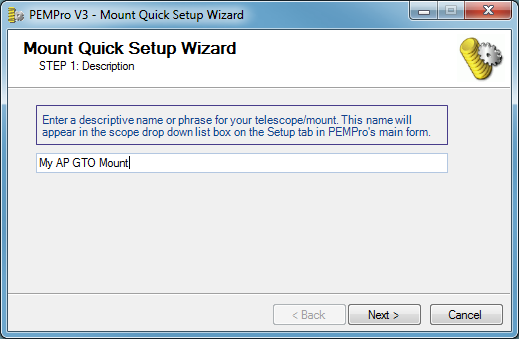
Press Next> to continue. Select the mount that you are using from the drop down list in Step 2. If you are not using an Astro-Physics mount but have the GTOCP3 (or GTOCP4) controller then select AP GTOCP3 Controller (or AP GTOCP4 Controller). In general, Rev D/E are GTOCP2.
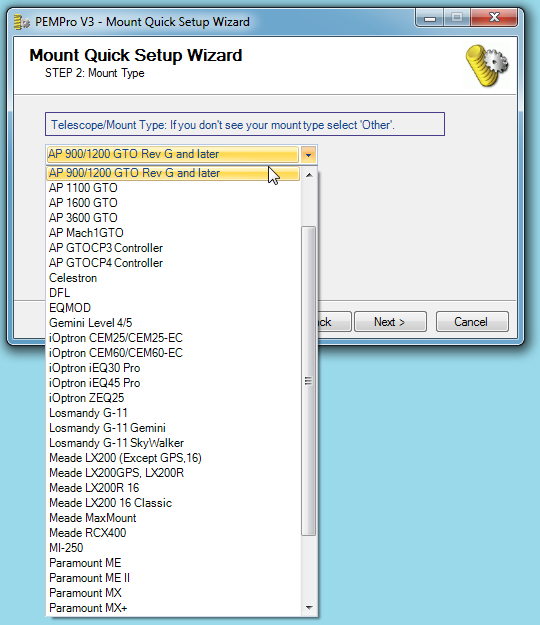
Click Next> to continue.
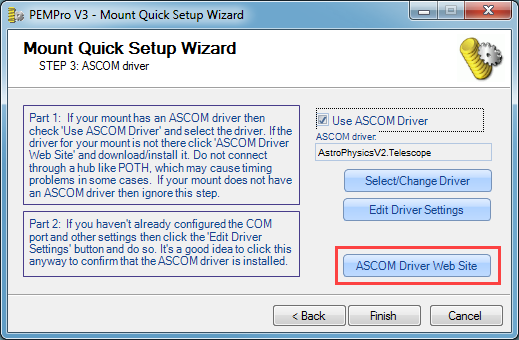
When Step 3 is reached the Astro-Physics V2 ASCOM driver will be automatically selected. The next thing you should do is verify your ASCOM driver is setup is OK by clicking Edit Driver Settings. At the time of this writing the driver setup page looks like this (version number is is near the top) .
Some general things to check:
1. Set the mount type.
2. Set the Controller type
3. If you are using APCC make sure you check "APCC Virtual Port".
4. Set the COM port.
5. Set the time out to 200 msecs to start with if you are not using APCC. If you are using APCC then set it to 500 msecs. If the driver ever reports COM errors try increasing this value.
6. Click the "Check Port" button to confirm that the mount connects.
7. If you do not have a site setup then click "Get Longitude/Latitude from Mount", give your site a name, and click "Save".
8. Set Unpark from "Last Parked".
Click "OK" to continue.
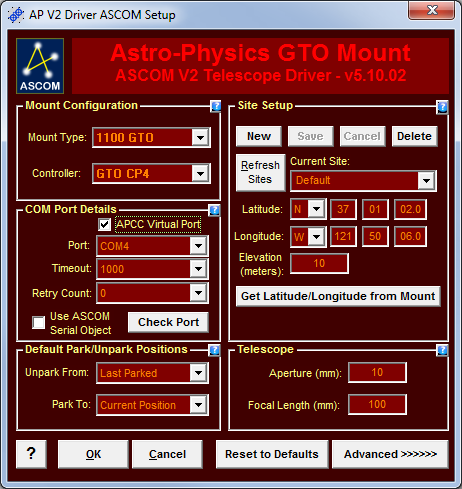
Run the Calibration Wizard before acquiring data
Once every session, before acquiring periodic data, you should run the Calibration Wizard. The Calibration Wizard sets all of the important parameters used by PEMPro to accurately calculate periodic error. Note that you don't need to run this wizard if you are analyzing data previously collected.
Some of the settings established include:
•Telescope declination
•Camera tilt angle
•Which axis of the camera corresponds to Right ascension
•Image Scale
•Telescope movement direction
Before starting the Calibration Wizard you should center a 6th-8th magnitude star in the center of your CCD camera. The star should be just west of due South and at 0 degrees declination or higher if you are in the Northern hemisphere.
If you are in the Southern Hemisphere, the star should be just West of due North and 0 degrees declination or lower. In either case it is best to pick a star within 45 degrees of the celestial equator (in Northern hemisphere: 0 < declination < +45, in Southern Hemisphere: 0 > declination > -45).
Make sure that Adjust Data for Declination is checked in the Settings Menu. While you are at it also make sure that De-Rotate Data is also checked. If either is not checked then enable them.
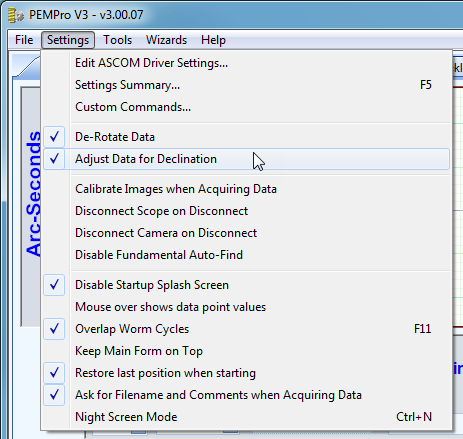
If you are in the southern Hemisphere check the option, "Southern Hemisphere".
Connect to the mount press the Connect Scope button on PEMPro's setup page:

If you do not have the latest version of the Astro-Physics V2 ASCOM driver a dialog will pop up warning you of that. At the time of this writing version 5.10.02 is the current version. You can always get the latest version from https://www.ascom-standards.org/Downloads/Index.htm
Select your camera control program and connect to your CCD camera by pressing the Connect Camera button. Also, make sure that Use Autoguider Port to Move Scope is unchecked.

To active the Calibration Wizard select its menu option:

If you are not familiar with the steps of the Calibration Wizard then you can find how to use it here.
Acquiring Data
Make sure that you are connected to the mount and the CCD camera as described above. Make sure that the AP Raw PE tab is showing. You will know you are connected when the scope and camera drop down list boxes are grayed out and the buttons say Disconnect Scope and Disconnect Camera as shown here:

Also make sure that AstroPhysicsV2.Telescope appears in the text box next to Configure Scope/Mounts.
Important: Do not connect to the mount through an ASCOM hub such as POTH. Make sure that the text field to the left of the Configure Scopes/Mounts button says AstroPhysicsV2.Telescope. If not, press Configure Scopes/Mounts and change the ASCOM driver to be the native Astro-Physics V2 driver. |
One other thing you will want to do is to make sure PEC is off. PEMPro has convenient buttons to turn the PEC on/off. If PEC is on then simply press the PEC OFF button.
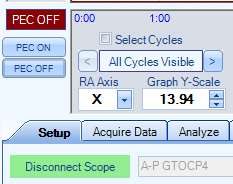
On the Acquire Data tab press the Start button.

You will be presented with one final opportunity to enable or disable the mount's PEC mechanism. If you are collecting data for an initial PEC curve then click Disable PEC before Acquiring. If you are measuring PE after uploading a PEC curve or are planning to refine your periodic error then click Enable PEC before Acquiring.
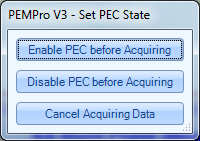
If you have Ask for Filename and Comments when Acquiring Data checked in the Settings menu, you will have an opportunity to change the default filename and add optional comments to the file. Click here for more details.
Before PEMPro takes any images it automatically queries the mount for the current worm position and synchronizes the data that it is about to collect to the mount's worm phase. This means that you can freely move the mount before acquiring data without the risk of forgetting to synchronize PEMPro to the mount.
Now, just sit back and let PEMPro collect 5-6 cycles of periodic data. The horizontal axis of the graph is worm phase and the vertical axis is the measured PEC. After each worm cycle the color of the data will change.
Note: The pictures below in this section are for illustration only. They are not from an Astro-Physics mount.
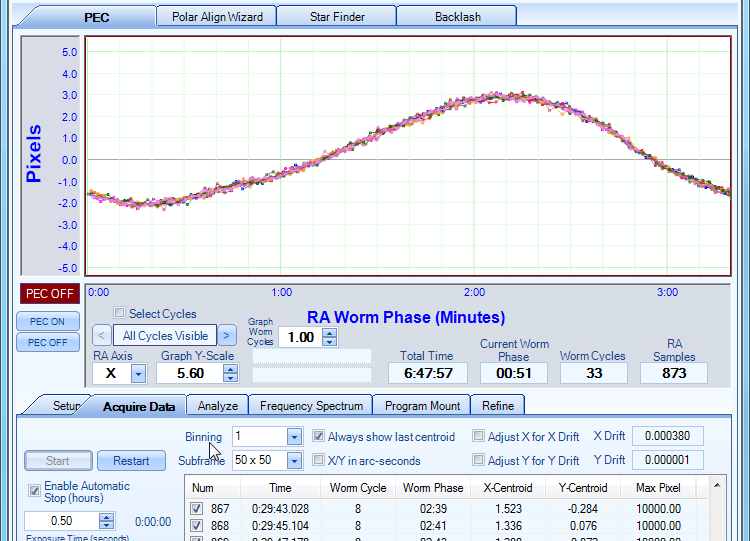
Click Stop when you are done collecting data. If you have Ask for Filename and Comments when Acquiring Data checked in the Settings menu, you will have a final opportunity to add comments to the file or delete the log file and start over. If you don't delete the file you will be prompted to go directly into the create curve dialog:
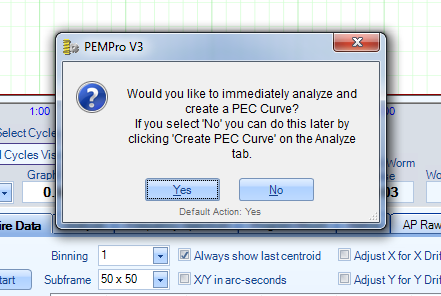
Click Yes to continue.
Create a PE Curve
You can create a PE correction curve immediately after acquiring data or use the log file created in a previous session. PEMPro places all log files in the directory specified in the Logs and Images Dir field on the Setup tab of PEMPro's main window.
When the create PE Curve dialog opens it may take a few seconds to calculate an optimum curve. In most cases you won't need to do any modifications to the curve. Advanced users may wish to add or remove fundamental frequencies to see how that effects the curve's fit, the measure of which is the RMS Error in the upper right of the dialog.
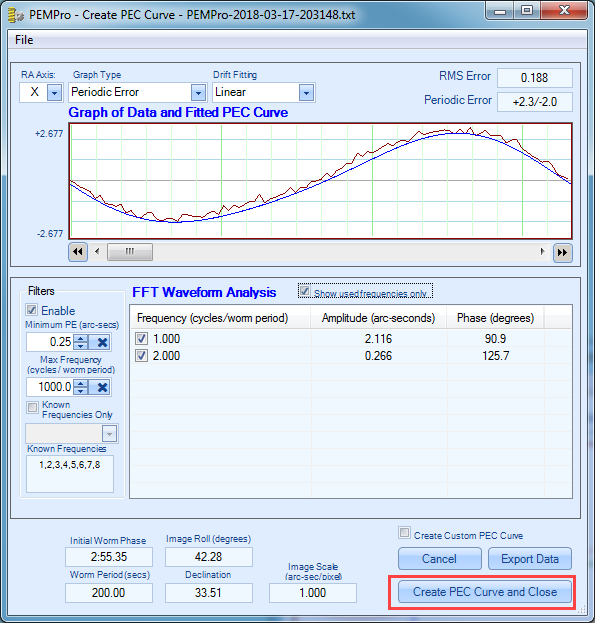
Before leaving this dialog take a moment to check that the Worm Period, Image Roll, Declination, and Image Scale look correct. If anything looks wrong click Cancel and go back to the Setup and Calibration Wizard to setup the parameters again. Otherwise press Create PE Profile and Close if you are satisfied with the curve.
Adjust Curve and upload to the mount
After the Create PE Curve dialog closes in the previous step, PEMPro will automatically switch to the AP Raw PE tab and ask if you want to upload to the mount. If you click Yes the curve is immediately uploaded to the mount and you are done!
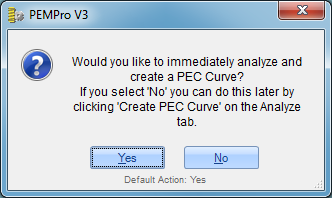
However, if you are an advanced user you may to click No so that you can first adjust the settings in the Modify PE Curve group. Controls on the AP Raw PE tab are explained below.
At the top of the graph Peak to Peak PE labels the total periodic error of the curve.
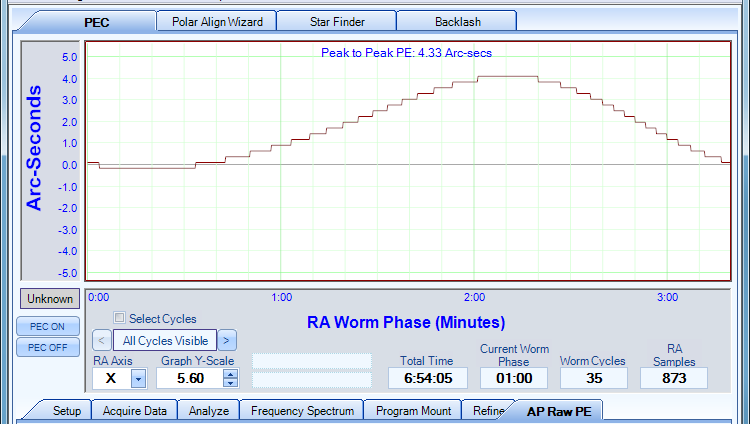
Check Corrected PEC
After you upload the new PE correction curve you will want to turn PEC On and acquire at least 2 worm cycles of data. If you see that the periodic error is worse than before you can go back to the AP RAW PE tab and press the Invert Curve button and then click To Mount to send the curve to the mount again. Then start the acquire data again. The mount's periodic error should be significantly reduced.
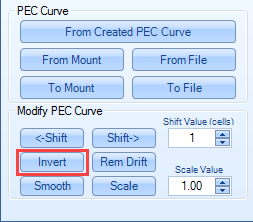
If, after checking the corrected periodic error of the mount you find that you want to try for further improvement you can use the Refine feature.
AP Raw PE Tab features
Below is the AP Raw PE tab before connecting to the mount. All the buttons and controls are disabled except the From File button and the Shift and Scale numeric up-down controls. If you click From File you can load in a previously saved PEC curve. The table will then fill with entries from the file and a graph of the curve will display.
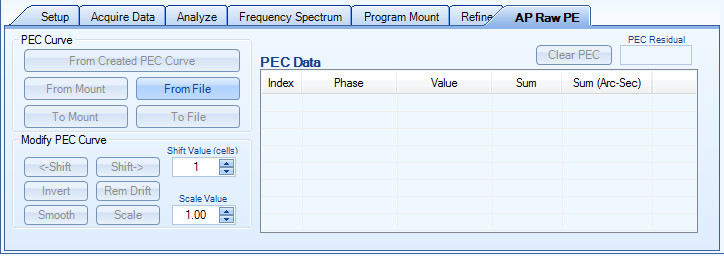
Once PEMPro is connected to the mount on the Setup tab, the From Mount button is enabled. Also the Firmware Rev is displayed, which should be a single ASCII letter. For instance, below this letter is "I". GTOCP3's are identified by their firmware revision. They are all Rev G or later.
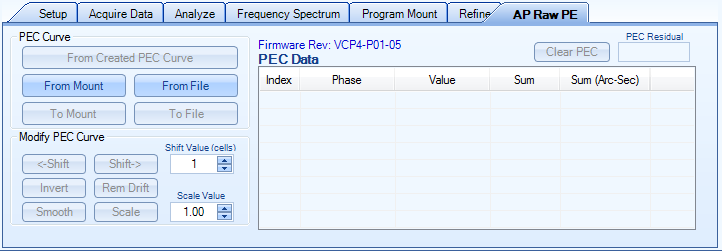
The From Created PE Curve button and all of the controls in the Modify PE Curve section are enabled if a curve has been created with the Create PE Curve dialog. Also all the controls will be enabled if a file is loaded with From File, or 3. From Mount is used to read the PE data.
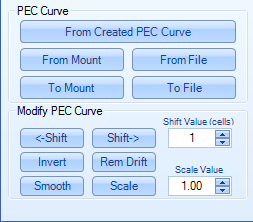
Here is a summary of all of the controls:
From Created PE Curve: loads a PE curve that has just been created or loaded.
A previously created curve (*.ppc) can be loaded through the Refine page. Just load a curve with the Curve 1 button then go to the Program Mount section and press Use Curve. You can then import the curve to the AP Raw PE tab by pressing the From Created PE Curve button:
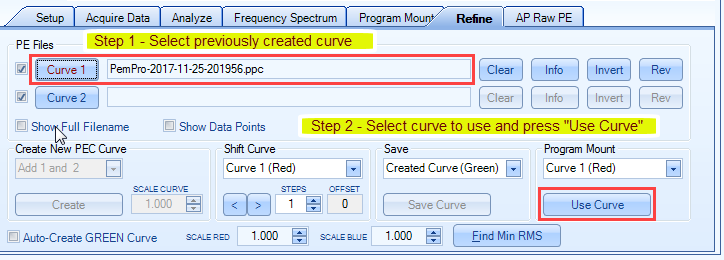
These are the functions you can do to the periodic error curve as a whole:
<-Shift - Shifts the curve left by the number of cells in the Shift Value field. The cells of the GTOCP3 vary depending on the worm period. There are 970 cells total which means that for a mount with 383 seconds, each cell is about 0.4 seconds. So the time shift of one cell is 0.4 seconds. Note that since the left hand edge of the graph always starts at 0 the whole level of the curve will change as you shift, however the shape and magnitude of the curve will not change. Here is a picture showing an example of shifting a curve:
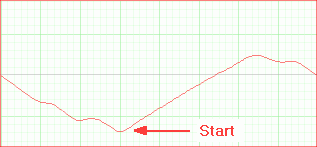
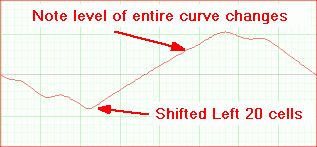
-----------------------------------
Shift-> - Shifts the curve right by the number of cells in the Shift Value field. The cells of the GTOCP3 vary depending on the worm period. There are 970 cells total which means that for a mount with 383 seconds, each cell is about 0.4 seconds. So the time shift of one cell is 0.4 seconds. Note that since the left hand edge of the graph always starts at 0 the whole level of the curve will change as you shift, however the shape and magnitude of the curve will not change.
Invert - Inverts the curve as shown below. You would use this button on your curve if the curve causes the mount's periodic error to double instead of reducing it.

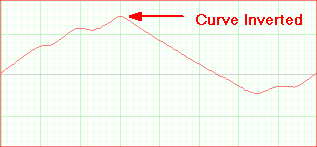
Smooth - Does a very modest smoothing of the curve. The Smoothing consists of doing a weighted average of each cell with its the two nearest neighbors.
Scale - Scales the curve by the factor in Scale Value. If a curve over or under corrects the periodic error of your mount you could use this to fix the curve without re-acquiring data.
Clear PEC - Fills the entire PEC table with 0's.
IMPORTANT: After making adjustments to a PEC curve with any of the above buttons you will need to write it to the mount with the To Mount button.
